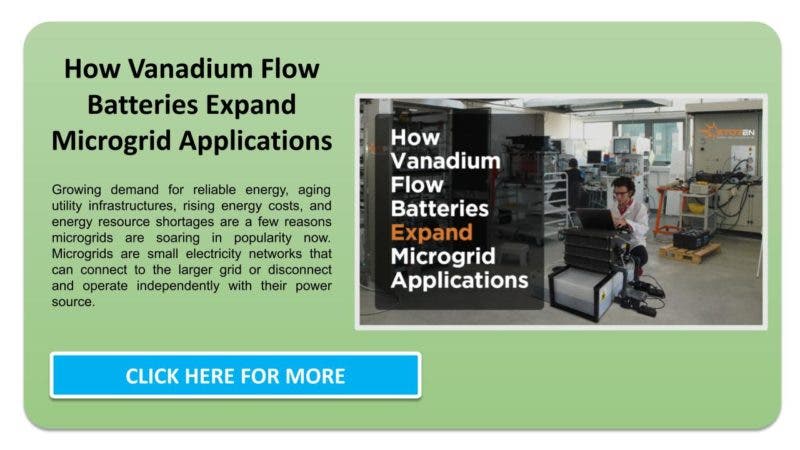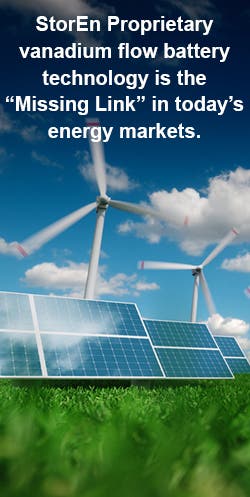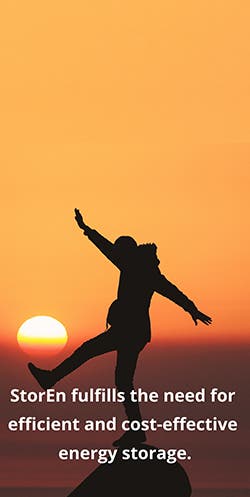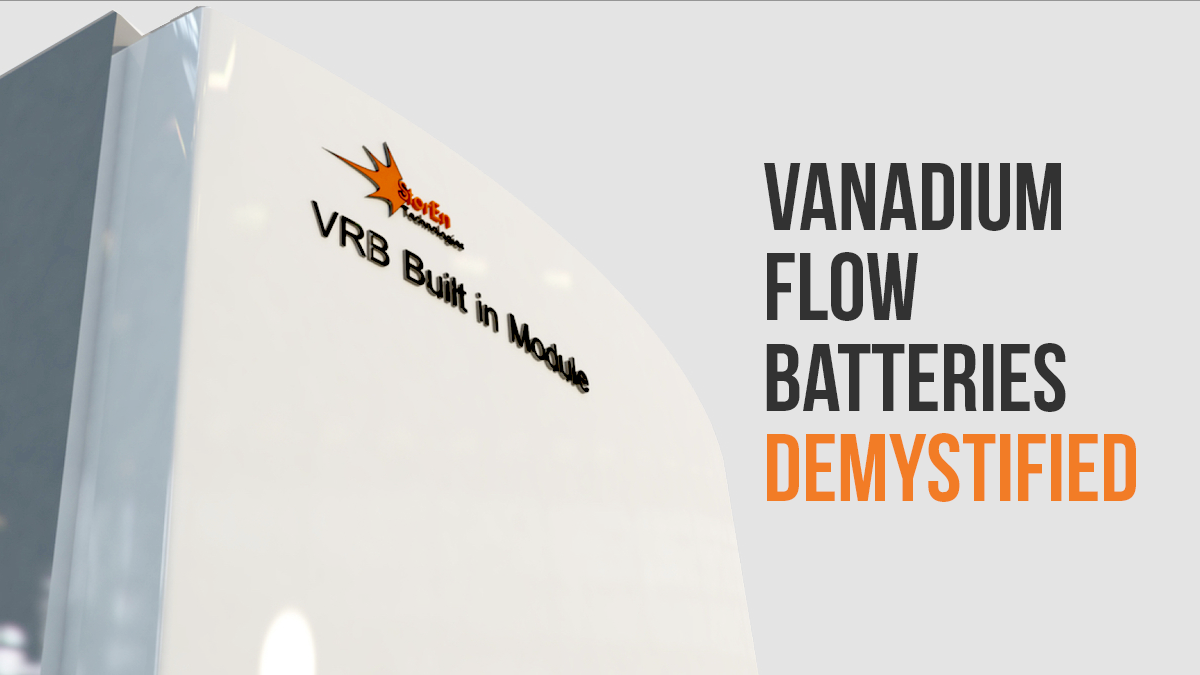
Understanding Today’s Hottest New Energy Storage Technologies – Vanadium Flow Batteries
Vanadium flow batteries are gaining attention in the media, various industries, and even the general public for the many benefits over lithium-ion batteries.
Those benefits include longer life, very little degradation of performance over time, and a much wider operating temperature range. All of which significantly reduces the cost of ownership.
The vanadium flow battery (VFB) is a rechargeable electrochemical battery technology that stores energy in a unique way. In contrast to lithium-ion batteries which store energy using solid forms of lithium, flow batteries use a liquid electrolyte stored in tanks. In VFBs, this electrolyte is composed of vanadium dissolved in a stable, non-flammable, water-based solution. Vanadium is a non-toxic, widely-available metal that is typically used for making steel.
How do Vanadium Flow Batteries Reduce Costs?
Vanadium flow batteries offer lower costs per discharge cycle than any other battery system. VFB’s can operate for well over 20,000 discharge cycles, as much as 5 times that of lithium systems. Therefore, the cost of ownership is lower over the life of the battery.
Power and energy are decoupled or separated inside a vanadium flow battery. Power is expressed by the size of the stack; the energy by the volume of electrolyte in the tanks.
This attribute means that a flow battery can be more accurately scaled to fit any application. Lithium systems have specific power and energy specifications based on the manufacturer model. When specifying a lithium energy storage system, the user is required to oversize the system to make sure it fits the specific power and energy requirements of the site. Also, VFB systems do not degrade over time and can be designed to match the power and energy requirements of the site. Lithium systems must compensate for the natural degradation of the system and thus must be initially oversized, which costs more over the life of the system.
Vanadium Flow Batteries Offer Environmental Benefits
From an environmental viewpoint, in addition to lithium, lithium batteries contain a variety of metals such as nickel and cobalt.
Lithium-ion batteries have “the highest (compared to other battery technologies) potential for environmental impact,” according to a recent U.S. Environmental Protection Agency report entitled “Design for the Environment.”
The EPA also cited additional negative environmental consequences from lithium-ion batteries like:
- Mining
- The climate crisis
- Environmental pollution
- Human health impacts
Under United States regulations, lithium-ion batteries received a Class 9 miscellaneous hazardous materials classification (40 CFR 173.21(c)). This classification is higher than lead-acid batteries, which are Class 8.
Recycling Lithium Batteries is Expensive
The first issue is that most metal used in lithium batteries comes primarily from mining. Kelleher Environmental estimates that only 45% of the lithium-ion batteries sold annually will be recycled in 2024.
It’s necessary to process spent batteries to recover the metal to reduce mining. But currently, the process only recovers between 3-5% of the metal inside the batteries.
Another issue that makes recycling expensive is that lithium batteries’ classification as hazardous waste increases fees associated with transportation, toxic metal treatment processing, disposal, and regulatory compliance.
Lithium batteries not correctly disposed of and landfilled represent an environmental hazard due to possible toxic metal leakage.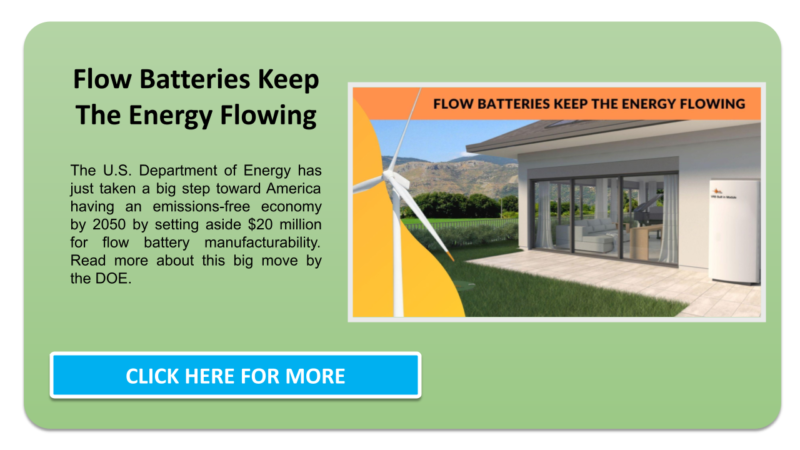
Vanadium Batteries Have Greater Recyclability
The main environmental advantages of vanadium technology are:
- All major components are made of fully recyclable plastic and metals
- With all parts bolted together, disassembling is very easy
- Processing is cost-effective due to the majority of parts being primary mechanical reprocessing
The only two components that need special treatment are:
- The Printed Circuit Board of the Battery Management System, which requires the same process that used for electronic waste such as computer motherboards
- And the electrolyte, which requires chemical processing
With vanadium flow batteries, all parts and components have a recyclability factor close to 100%. The electrolyte can be processed and reused; 100% of the vanadium can be extracted and reused for other applications with no impact on primary mining.
Also, these batteries contain no toxic metals such as lead, cadmium, zinc, and nickel. One more advantage of these batteries – the acidity levels are much lower than lead-acid batteries.
In its lifespan, one StorEn vanadium flow battery avoids the disposal, processing, and landfill of eight lead-acid batteries or four lithium-ion batteries.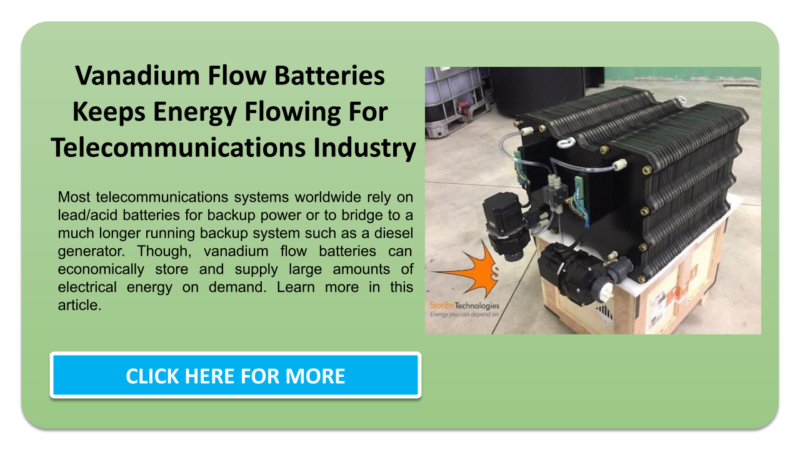
Read more about StorEn Technologies here.

